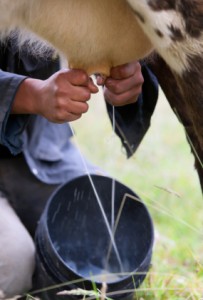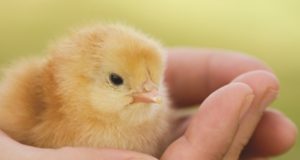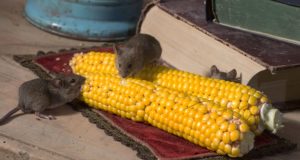So you’ve started your homestead, you’re living off the land, at least partly, and you have begun to invest in animals. Maybe you have a goat or two, some rabbits, or chicken. It might be time to think about cows. You may not be ready for a herd of beef cattle, but how about one cow for milking? You can have your own fresh milk every day. You can also make your own butter and cheeses, fresh and preservative free. The idea may seem intimidating at first, but getting one milk cow is not huge chore. With the right information, you can choose the right cow, pay the right price, and care for it well while adding to your family’s food supply and your independence from the supermarket.
Choosing Your Cow
 This may be the most important step you take towards getting yourself a milking cow. If you pick the wrong cow, you will be a saddled with a large animal that just doesn’t work for your needs. Do plenty of research before you make a final selection. Learn about all of your options and talk to other people in your situation. If you know other homesteaders or participate in online forums with other families who are off the grid, find out what kind of cows they have used for milking and any problems or successes they have had. Learn from the experiences of others before you have to learn from your own mistakes.
This may be the most important step you take towards getting yourself a milking cow. If you pick the wrong cow, you will be a saddled with a large animal that just doesn’t work for your needs. Do plenty of research before you make a final selection. Learn about all of your options and talk to other people in your situation. If you know other homesteaders or participate in online forums with other families who are off the grid, find out what kind of cows they have used for milking and any problems or successes they have had. Learn from the experiences of others before you have to learn from your own mistakes.
There are six major breeds of dairy cow in the U.S. They are Brown Swiss, Guernsey, Jersey, Holstein, Milking Shorthorn, and Ayrshire. The most common dairy cows are the Jersey and Holstein breeds, so these will likely be the easiest to acquire. A Jersey cow is small, weighing in at about 800 pounds when fully grown. The benefits of having a smaller cow is that you will have to feed her less, but you will also get less milk than from a larger cow. Jersey milk is rich and high in fat.
A Holstein is much larger and can be as much as 1200 pounds when fully grown. This means that you will have to feed her more, which is more expensive, but you will also get more milk. The milk from a Holstein is less fatty than Jersey milk, so it will not make butter or cheese that is as good as that from a Jersey cow. For many homesteaders, a smaller cow is a good option. You need less room and less feed, and she may be easier to handle. Unless you feel you will need a high volume of milk, a smaller cow is probably your best bet.
Another option is to get a miniature cow. Both Jerseys and Holsteins come in miniature varieties, with full-grown heights ranging from 36 to 48 inches in height. If you get a cow that is too small, though, you will struggle to milk her. It is something you need to do every day, so the low height can quickly become a problem. A miniature cow may give you a gallon or two of milk each day, while a standard-sized Holstein can give between five and ten gallons.
Buying Your Cow
Once you have made a selection for the type of cow you want, it’s time to buy. Cows are not cheap, but beware of those that are being sold at a discounted price. These are often the cows that are being culled for a good reason. Maybe she carries diseases, or she produces too little milk. She may have damaged udders. If the only problem with a sale cow is that she is producing too little for a dairy farmer to be profitable, this could be your cow. To supply your family, you don’t need a huge producer. You should also consider a cow with damaged teats. This will make her produce less, but that might be okay for your family. Just avoid cows that are at a discount for reasons of disease or disposition. A shy or nervous cow will be a real pain to milk every day. If you are uncertain about disease or the health of a cow, ask your vet to check her out first. It will be well worth the time and extra cost.
Homegrown Dairy Products, Fresh from Your Yard
Feeding Your Milk Cow
Once you have your lovely girl back at the homestead, make sure you take excellent care of her. A healthy and happy cow will reward you with milk, and even affection, for years to come. Whether you feed your cow, let her out to pasture, or both, is up to you. The most natural way for a cow to feed is on grass in a pasture. Depending on the quality of your pasture and the size of your cow, you will need between one half to one and a half acres.
When your cow is not on pasture, you can give her a diet of high quality alfalfa hay with mineral supplements. Feeding a cow grain is a typical way to fatten her up and to make her produce more milk, but it is not the natural way for a cow to eat. Her stomachs naturally contain just the right bacteria to convert pasture grasses into beef and milk. However, if you choose to feed her grains, you can find guidelines in any book on raising cattle.
Milking
Finally, you get to the reason for having a cow in the first place. Your cow will need to be milked every day. You can do it twice a day, but it may be easier to just do it once. You need not stick with an absolutely rigid schedule, but you should milk her around the same time each day, like between six and eight in the morning. To make milking easiest for both of you, build a stanchion or milking stall to restrain her. Keep a bucket of grain in here to lure her in. Eventually, with the grain and a schedule, she will know when to come into the stall and you won’t have to lead her in.
Never hit, shout at, or scold your cow when she misbehaves in the stanchion. She won’t like it first, and it will take time for her to get accustomed to the arrangement. But the last thing you want to do is give her negative associations. Be calm and be patient. Make sure the stanchion is narrow enough that she can’t turn around and sturdy enough that she can’t kick it down and hurt you.
Before milking, wash the udder with a mild soap. You can get a soap specifically for this purpose at your veterinarian’s office or at a farming supply store. It may take you a few tries to hone your milking technique, but the idea is to squeeze the milk out, not pull. Don’t be afraid of hurting your cow; just squeeze as hard as you need to in order to get the milk going. Squeezing should start at the top of the teat. Work your way down to the bottom.
This won’t be easy for either of you if it is your first experience milking, but with time it will become a regular and manageable chore. You will need to figure out with time what works best for you and your cow. With practice, you will learn where the best place is for the bucket, how to sit, how to squeeze, and how to get the milk out. Your cow will get comfortable with you and will easily come into the stall for milking every day. And you and your family will be rewarded with fresh and tasty milk with leftovers for cheese and butter.
Discover many ways to make your own homemade dairy creations
Drinking The Milk
Pasteurization is recommended by most experts before drinking your milk, but there are plenty of homesteaders who drink their milk fresh and raw. Pasteurization means heating the milk to kill microorganisms. It needs to be heated to 140 degrees for 30 minutes. This can be done on the stove with a double boiler. Just be sure to stir as it heats to avoid uneven heating.
Even if you are pasteurizing your milk before drinking it, cleanliness is very important. Make sure all your utensils are thoroughly cleaned and disinfected before milking. And wash the cow’s udders before every milking session. Your hands can also introduce germs, so wash them before milking and avoid letting the milk touch you before it hits the bucket.
©2012 Off the Grid News
 Off The Grid News Better Ideas For Off The Grid Living
Off The Grid News Better Ideas For Off The Grid Living




